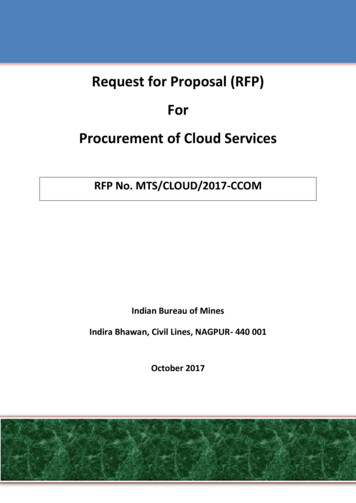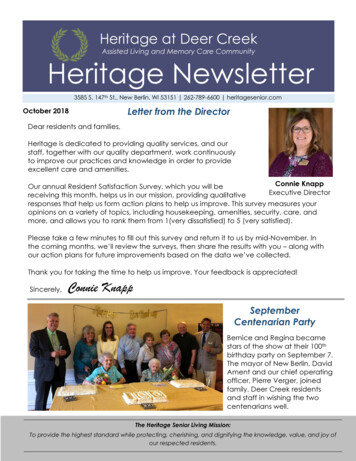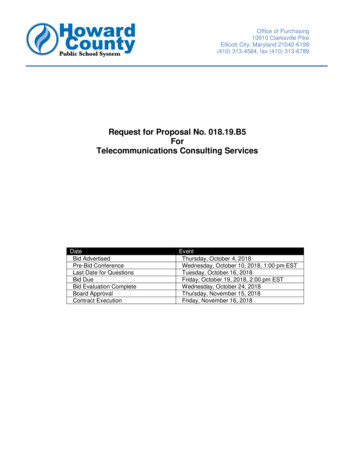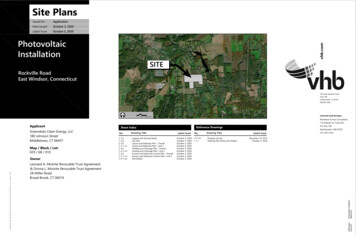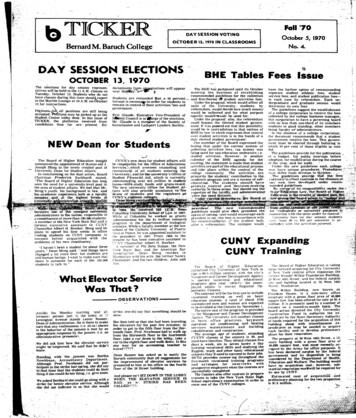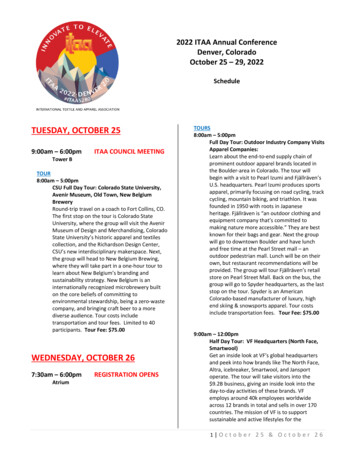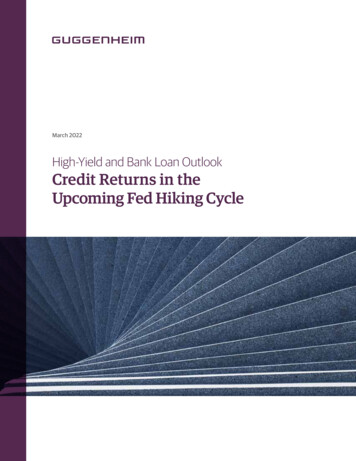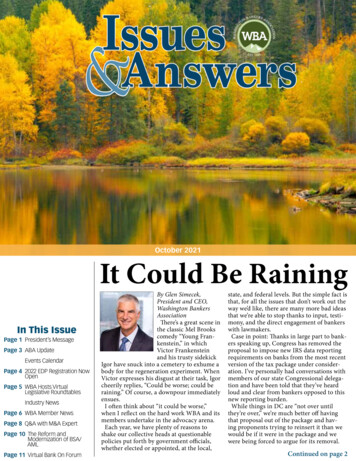
Transcription
October 2021It Could Be RainingIn This IssuePage 1 President’s MessagePage 3 ABA UpdateEvents CalendarPage 4 2022 EDP Registration NowOpenPage 5 WBA Hosts VirtualLegislative RoundtablesIndustry NewsPage 6 WBA Member NewsPage 8 Q&A with M&A ExpertPage 10 The Reform andModernization of BSA/AMLPage 11 Virtual Bank On ForumBy Glen Simecek,President and CEO,Washington BankersAssociationThere’s a great scene inthe classic Mel Brookscomedy “Young Frankenstein,” in whichVictor Frankensteinand his trusty sidekickIgor have snuck into a cemetery to exhume abody for the regeneration experiment. WhenVictor expresses his disgust at their task, Igorcheerily replies, “Could be worse; could beraining.” Of course, a downpour immediatelyensues.I often think about “it could be worse,”when I reflect on the hard work WBA and itsmembers undertake in the advocacy arena.Each year, we have plenty of reasons toshake our collective heads at questionablepolicies put forth by government officials,whether elected or appointed, at the local,state, and federal levels. But the simple fact isthat, for all the issues that don’t work out theway we’d like, there are many more bad ideasthat we’re able to stop thanks to input, testimony, and the direct engagement of bankerswith lawmakers.Case in point: Thanks in large part to bankers speaking up, Congress has removed theproposal to impose new IRS data reportingrequirements on banks from the most recentversion of the tax package under consideration. I’ve personally had conversations withmembers of our state Congressional delegation and have been told that they’ve heardloud and clear from bankers opposed to thisnew reporting burden.While things in DC are “not over untilthey’re over,” we’re much better off havingthat proposal out of the package and having proponents trying to reinsert it than wewould be if it were in the package and wewere being forced to argue for its removal.Continued on page 2
Continued from page 1Issues & Answers – October 2021The official publication of the Washington BankersAssociation is sponsored by Harland Clarke and WBAProfessional ServicesWBA StaffGlen Simecek, President & CEO(206) 447-1700,glen@wabankers.comLiz Wilson, EVP & Chief OperatingOfficer(206) 344-3495,liz@wabankers.comSecretary/Treasurer: Brent Beardall,President & CEO, WaFd BankEducation Committee Chair: MattDeines, President & CEO, FirstFederalWBA PROS Chair: Ken Johnson,EVP/Operations, Banner BankKyle Hayden, Controller(206) 344-3476,kyle@wabankers.comABA Community Bank CouncilRep: Eric Pearson, President & CEO,Community First BankKatherine Nyerick, Director ofEducation(206) 344-3484,katherine@wabankers.comDirectorsDuncan Taylor, SVP, Programs &Member Services(206) 344-3492,duncan@wabankers.comSherry Krainick, Operations &Education Manager(206) 447-1700,sherry@wabankers.comMegan Managan, Director ofCommunications & GovernmentRelations(206) 344-3472,megan@wabankers.com2021-2022 Board ofDirectorsChair: Joe Kiley, President & CEO,First Financial Northwest BankABA GR CommitteeRepresentative: Mark Mason,President & CEO, HomeStreet BankImmediate Past Chair: Jon Jones,CEO, Washington Business BankJay Coleman, SVP & RegionalCredit Officer, KeyBankJack Heath, President & COO,Washington Trust BankSusan Horton, Chairman, President& CEO, Wheatland BankBryan McDonald, President &COO, Heritage BankBrian Mulvaney, Market President,Union BankGreg Oakes, President & CEO,Cashmere Valley BankGail Rasmussen, CommercialBanking Cross Segment Leader,Wells FargoKerri Schroeder, President - Seattle,Bank of AmericaLaurie Stewart, President & CEO,Sound Community BankClint Stein, President & CEO,Columbia BankDave Swartley, SVP/ManagingDirector State GovernmentRelations, U.S. BankContact UsContact the Washington Bankers Association at 601 UnionStreet, Suite 1720, Seattle, WA 98101Call us at (206) 447-1700 and visit us on theweb at www.wabankers.com.Connect With UsConnect with the WBA online by following us on our socialmedia accounts.On the CoverFall colors reflect brightly in the Wenatchee River outside ofLeavenworth, Wash. The area attracts thousands of visitors eachyear to witness the changing of the seasons.Photo courtesy Washington State Department of Natural ResourcesAnother important issue is playing out in “our Washington.”By now, most bankers are probably aware of the recentlegislation to establish a new, 36,500-per-individual longterm care (LTC) benefit, publicly funded by a new payrolltax of 0.58 percent on employee wages. Employees can opt ofthe state program and tax by providing proof of private LTCcoverage but only have until November 1 to do so.WBA has joined the broader business community, led by theAssociation of Washington Business, in urging the Governorand Legislature to suspend or at least slow implementation ofthis new program.We’ve collectively pointed out several problems with thelaw as written. The November 1 deadline for individuals todemonstrate that they have obtained private coverage is unrealistic, given the small number of carriers currently operatingin our market and the volume of applications they’re receiving. The Employment Security Department does not appearready to process exemption applications promptly, whichcould result in some employees paying for both a private policy and the public program for some time – with no provisionfor state refunds when that happens. And several eligibilityprovisions will result in some employees paying the tax – potentially for many years – without receiving the benefit.This bill is an example of the Legislature moving quickly onwhat is arguably a laudable goal, ensuring that more Washingtonians have more resources to pay for the care they couldneed as they age. But it’s also an example of why businesses,and especially bankers, need to explain the real-world consequences of legislation clearly and consistently.This has been an important subject of discussion in ourlegislative roundtable meetings, and we’ve heard some lawmakers acknowledge that changes will have to be made to theprogram come January and the 2022 session. That’s an encouraging sign, but we need to keep up the volume, so everylegislator understands the importance of this issue and theneed to take action.I urge you to take some time to learn more about the detailsof the new law and share that information with your employees and your customers who will also be impacted and maynot be focused on the issue. Encourage them to ask questionsand share their concerns with their representatives in Olympia.As it currently sits, the long-term care program has seriousproblems. Working together, we may be able to correct someof its flaws and make it better.Time and again, we see that when bankers speak up on important issues, it makes a big difference with lawmakers andthe broader community they represent. This is a very goodthing because we all know that another raincloud is bound tocome along.
Banking On Inclusion: America’sBanks Embrace Bank On MovementEventsCalendarBy Rob Nichols, President & CEO,American Bankers AssociationAmerica’s banks have a longstanding commitment to helping reducethe number of unbanked and underbanked individuals and familiesin the U.S. July marked a majormilestone in that endeavor, with anannouncement from the Cities forFinancial Empowerment Fund thatthe number of Bank On-certified deposit accounts nowavailable has surpassed 100. At the time this columnwas written, it was up to 114.As you may recall, nearly a year ago I challengedbanks of all sizes to offer Bank On-certified products,which are designed to promote access to financialservices to the roughly 5% of U.S. households thatremain unbanked. To receive Bank On certification,the account must meet certain standards, including lowcosts, no overdraft fees, robust transaction capabilitiesvia a debit or prepaid card, and free online bill pay. Thecertification is free and the process is simple.When I issued that challenge in October 2020, therewere 43 banks offering accounts that were BankOn-certified. Today, there are more than 90, withplenty more in the process of obtaining certification. Inparticular, we’ve seen a significant uptick in the number of community banks offering Bank On-certifiedaccounts. This is due in part to ABA’s efforts to engagewith 20 of the nation’s core technology providers—including Fiserv, FIS, Jack Henry and Associates, andFinastra—and encourage them to simplify the processfor their bank clients to create and offer these important products.Today, Bank On accounts are available in more than32,500 branches, in 99 out of the 100 largest metropolitan markets, and in all 50 states. They have receivedplaudits from bank regulators and policymakers alike—and for good reason. Research suggests that the initiative is working as intended: according to the FederalReserve Bank of St. Louis, 75% of consumers openingBank On certified accounts were new customers forthat bank. Additionally, while these accounts havewidespread appeal, CFE Fund reports that close to 60%of Bank On certified accounts were opened by customers in communities with 50% or more people of color.The importance of having a banking relationship hasnever been more apparent than during the COVID-19pandemic. From obtaining Paycheck Protection Program loans to receiving economic impact paymentsquickly, there are countless stories that speak to thebenefit of having a trusted banking partner—and to thedisadvantages of not having one.“For a long time, we’d known that we have consumersthat don’t have bank accounts in our market. It couldbe for cost, it could be for convenience, there could be alot of reasons. The stimulus checks brought the issue tolight a little more,” says Gary Kleer, CEO of First BankRichmond in eastern Indiana, whose bank recentlyhad its Easy Fit Checking Account Bank On-certified.“When we saw this initiative being offered, we decidedto get on board so that we could offer our consumers amore safe and affordable way to handle their money.”As we strive for a more equitable and inclusive society,one of the most constructive ways banks can help movethe needle is to ensure that every American has theopportunity to access the banking system. That’s whythe Bank On certification is so important—it signalsto those who may be hesitant to come in the door andstart that banking relationship that the bank offers aproduct they can trust to meet their needs.Many banks are already offering checking accountoptions that meet Bank On standards—but it’s timeto go the extra step and get them certified – for free –with the Bank On seal of approval. If you haven’t yet, Iencourage you to visit www.aba.com/BankOn to learnmore about the Bank On movement, how to certify anaccount product and why other banks were motivatedto get involved. ABA staff is available to meet with yourbank about the Bank On process and to answer yourquestions; reach out anytime through our dedicatedinbox: bankon@aba.com.Together, we can bring more Americans into thebanking system—a crucial step toward ensuring economic prosperity for all.October 6 – 2021 Hybrid Retail Branch ManagerDevelopment ProgramNovember 4-5 – Virtual Women in Banking ConferenceDecember 2-3 – Virtual Bank Executive ConferenceJanuary 26, 2022 – Executive Development ProgramFebruary 10-11, 2022 – NW Compliance Conference,DoubleTree Suites, SouthcenterMarch 2-3, 2022 – Virtual Senior Credit ConferenceMarch 29, 2022 – Retail Sales & LeadershipConference, Washington AthleticClub, SeattleMarch 31, 2022 – Marketing Conference, DoubleTreeSuites Seattle AirportTo register or to learn more about any of the listed events, please visit www.wabankers.com/calendar.
Executive Development ProgramRegistration Now Open for 2022Registration is now open for the WBA’s flagship ExecutiveDevelopment Program.This comprehensive 12-month program focuses on the skillsbankers need to take on executive roles within their organization. Sessions cover a variety of topics, including today’sbanking environment, leadership and management, financialprofitability, liability and assets, credit and risk review, auditand compliance, and much more. In 2022, the program hasbeen updated to include a focus on cybersecurity and the roleof fintech partnerships.One of the highlights of the program is the one-on-onementorship, one of the few opportunities in the country forthis type of program. Students are paired with executives fromtheir organization, meeting regularly to deepen the understanding of topics discussed during class.With over 400 graduates of the program since 2010, graduates have gone on to fill executive roles, including CEO.Classes begin January 26, 2022, and will run through November. The 2022 EDP will be held largely in-person, with classesat the Washington Athletic Club in downtown Seattle, withsome sessions held virtually.This popular program regularly sells out, so interested students are recommended to register early.At the beginning of October, the hybrid Retail Branch Manager Development Program will kickoff. This program wasredesigned in 2019 to fit the current retail banking environment. Sessions run through March and will be held virtually,except for the final class, which will be held at the WBA officein Seattle.Students will gain a broader understanding of the retailbranch market, build interpersonal communication skills,and how to strengthen client relationships.The 2021 Virtual Women in Banking Conference will be heldon November 4-5. The conference runs from 8:30 a.m. to nooneach day and will feature a session with Elizabeth McCormick,a decorated U.S. Army Black Hawk helicopter pilot who willshare leadership lessons she learned not only as a member ofthe armed forces but in business as a contract negotiator andcommodity manager.On December 2-3, WBA will host the 2021 Virtual BankExecutive Conference. The conference will run from 8:30 a.m.to 4 p.m. on December 2, followed by a half-day from 8:30a.m. to noon on December 3. The agenda will feature sessionson the economic outlook, regulatory and legislative trends towatch, and more. This year, banks can send an unlimited number of attendees because registration was included in WBAmembership dues.The 2022 Northwest Compliance Conference will be heldFebruary 10-11 at the DoubleTree Suites by Hilton, SeattleAirport Southcenter. The conference features returning speaker Leah Hamilton, vice president, and senior consultant atProBank Austin. Attendees can choose between attending twodays or one.The Retail Sales and Leadership Conference, to be held onMarch 29. This conference will be hybrid, with in-personattendees congregating at the Washington Atheltic Club andbanks can choose a virtual option to best fit their needs basedon the number of attendees.The 2022 Marketing Conference returns in person next yearand will be held on March 31 at the DoubleTree Seattle Airport. Amber Farley, executive vice president of brand development at Financial Marketing Solutions, will headline the eventwith a session on the current media landscape and what areasbanks should be focused on.Please visit the WBA website at www.wabankers.com for moreinformation about registration for any of our upcomingprograms.
Bankers Meet with Washington PolicymakersDuring Virtual Legislative RoundtablesThroughout September, bankers fromacross the state met with local lawmakers aspart of the annual Legislative Roundtables.Held virtually again in 2021, the events featured a robust discussion with policymakerson a variety of issues.Lawmakers had many questions, includingasking for updates on PPP and the generaleconomy, given the resurgence of COVIDthis fall. According to Small Business Administration data, as of June, Washington’sbanks had approved 91,000 PPP loansworth 5.88 billion in just 2021. Nationally,95 percent of all PPP loans were approvedby banks and almost half of all loans in theprogram had applied for forgiveness.Bankers also shared with lawmakers howcredit unions continued expansion intobusiness lending and other areas is makingit difficult for bankers to compete. WBAalso discussed how a new proposal thatwould give credit unions the ability to makemassive equity investments is a bad publicpolicy.Other issues discussed included the proposal around a public finance cooperative(previously known as a state bank), consumer data privacy, first mortgage interestdeduction, and more.Thank you to all of the bankers who participated in this year’s Roundtables!Industry NewsTracey LockwoodCommercial Lending Production and Servicing Manager at SaviBankNew HiresKrista JonesVice President and Mortgage Loan Center Manager at Peoples BankGerald MatasyRegional Credit Analyst Manager at First Interstate BankAli AlsosSenior Vice President and Senior Operations Manager at SaviBankEmily WahlLoan Coordinator at Liberty BankPromotionsKirstin TynerBranch Manager at Coastal CommunityBankTracy NguyenVice President and Marketing and Business Development Managerat Mountain Pacific BankJack SullivanVice President, Branch Manager at Coastal Community BankKarlee MungerSenior Vice President and Retail Banking Manager at MountainPacific BankBrett CaneVice President and Private Banking Relationship Manager atWashington Trust BankMarcus DuffySenior Vice President and Commercial Lender at Mountain PacificBankJose GonzalezSmall Business Banker at Washington Trust BankHave Industry News to share with WBA? Email megan@wabankers.com or call (206) 344-3472.
WBA Member NewsFirst Federal Donates to Other Bank During GrandOpening EventAs part of the celebration of First Federal’s new Ferndalebranch, the bank donated to the Other Bank.The branch also collected several donations of hygiene itemsto be donated to families in need.“We’re so happy to be part of the Ferndale spirit,” said thebank on social media.Olympia Federal Recognized Nationally for CommunityServiceThis summer the Independent Community Bankers ofAmerica (ICBA) announced that Olympia Federal Savings received an honorable mention in their 2021 National Community Bank Service Awards. The awards celebrate the outstanding and creative volunteer efforts by community banks acrossthe country.Olympia Federal was one of seven banks to receive the recognition, which was awarded for its Better Fedder program,supporting affordable housing and local nonprofits.“Our Better Fedder program is a multi‐dimensional community outreach initiative designed to improve the quality of lifefor people who call the South Sound home,” said Ryan Betz,vice president of marketing and public relations at OlyFed.“We are appreciative of this recognition, which aligns with ourmission of putting people above the bottom line to improve theoverall economic health and social well‐being of the community.”In 2020, the bank donated more than 465,000 in grants andsponsorships to 110 local nonprofits and has provided morethan 14 million in affordable housing loans.First Interstate Hosts Annual Volunteer Day in September1st Security Donates to Local Students During Stuff the BusCampaignJust before the beginning of the school year, 1st SecurityBank of Washington announced it had donated over 41,000in school supplies and cash as part of the bank’s Stuff the Buscampaign.The bank donated supplies as well as matching funds to localschools to help students in need as they headed back to theclassroom for the first time in over a year.“We appreciate your participation in our 2021 Stuff the Busdrive and for helping students get back to school ready tolearn!” said the bank on social media.In early September, First Interstate Bank hosted its annualVolunteer Day, where branches throughout the bank close foran afternoon so employees can volunteer.In Spokane, members of the team volunteered at Second Harvest where they packed 6,000 bite-2-go kits for those in need.Seattle Bank Donates to Refugee Women’s AllianceEarlier this fall, Seattle Bank announced it would be making a 10,000 donation to the Refugee Women’s Alliance (ReWA) tohelp Afghan refugees.The ReWA provides refugees with long-term assistance inhousing and employment.“Just like so many past generations of immigrants and refugees, this wave of refugees bring their talents, passions, andgoals. Helping others find refuge and thrive again only makesour community that much stronger,” said the bank.HomeStreet Bank Donates to Edmonds CollegeThis fall, HomeStreet Bank announced a 5,000 donation toContinued on page 7
Continued from page 6Edmonds College.The funding is for the school’s Project Home Association,which the bank has supported for more than 10 years. It helpsstudents find and stay in housing, allowing them to continuetheir education.1st Security Bank Donates to Port Angeles CommunityPlayers1st Security Bank of Washington donated to the Port AngelesCommunity Players for 2,500.The donation will allow the group to upgrade their air system,making it safer for those who attend performances in thefuture.Peoples Bank Donates to Hand in Hand ImmigrationServicesPeoples Bank announced in mid-September it was makinga 5,000 donation to Hand in Hand Immigration Services,a Wenatchee-based organization with the mission to assist,motivate and empower immigrants and their families to obtainU.S. citizenship.The bank donated in honor of Gerda Balint, a mortgage loanofficer assistant in the bank’s Wenatchee Financial Center, whobecame a U.S. citizen on Citizenship Day on September 17.When she was 11, Balint moved to the U.S. from Sweden,not knowing any English. Her family moved from Florida toLynnwood, Wash., and eventually, Wenatchee, where she wenton to high school and eventually attended Central WashingtonUniversity. Balint graduated from CWU in 2018 and startedworking as a teller at Peoples Bank after obtaining her GreenCard.“It means a lot to me to be able to tell my story,” she said. “Thetest was probably one of the easiest parts. I say this because it’staken so long to get my citizenship. Be patient, keep persevering, and don’t give up because you can do it. Be proud of your-self and who you are; keep pushing for your goals and dreams.”First Financial Northwest Bank Auction Team Volunteers atJunior Achievement EventMembers of the First Financial Northwest Bank AuctionTeam volunteered at the Junior Achievement of WashingtonDare to Dream event in mid-September at T-Mobile Park.The annual event features a dinner and auction to help support Junior Achievement programs throughout the state and tohonor student’s success.Olympia Federal Announces Employee of the QuarterOlympia Federal announced earlier this fall that Laura Ingersoll, a training coordinator in the Human Resources Department, was the employee of the quarter.She was nominated for being a steady presence of supportand assistant to a variety of departments. She assisted the LoanTeam with system maintenance, worked with the Digital Teamon the launch of the bank’s new online banking system, andhas worked tirelessly to convert training to a virtual format.She also helped with the implementation of a new consumerloan system and was a backup trainer for customer servicerepresentative training.“Lauren is extraordinarily hard-working and upbeat, and issomeone you will find always encouraging others and volunteering to help a coworker or project team that needs extrasupport,” Lori Drummond, President & CEO said. “Lauren is afantastic example of our values in action, always thinking aboutothers and willing to help anyone in the Association who needsit. OlyFed is so lucky to have Lauren as a part of our team!”Yakima Federal CEO Named Chamber CEO of the YearIn early September, the Greater Yakima Chamber of Commerce announced that Leanne Antonio, president & CEO ofYakima Federal Savings & Loan was the CEO of the Year.Chelsea Snodgrass, CEO of the Central Washington Homebuilders Association, also earned the honor after the votes weretallied in a tie.As a member of the Chamber for over 100 years, YakimaFederal also earned the award for Member of the Year duringthe Chamber’s annual award ceremony.Antonio started her career at the bank in 1981 as a teller, ultimately being promoted to President & CEO in 2016.She also serves on the board of the Yakima Rotary Trust,Memorial Foundation, and is on the board of the Community Bankers of Washington and Impact Capital, a Washington-based CDFI.If you have WBA member news to share, please emailMegan Managan at megan@wabankers.com. Submissions are run on a space available basis.
WBA Endorsed Vendor: Harland ClarkeQ&A with a Merger and Acquisition ExpertBy Andy Saner, SVP, Product Engineering, VericastHow has digital transformationimpacted M&A activity in thefinancial sector?Digital transformation is a majordriver of merger and acquisitionactivity. Since the pandemic, digitalization has gone from a nice-to-haveoption to a need-to-have imperative,enabling financial institutions to reach beyond theirzip code and acquire customers without the need for anextensive branch network. Digitalization has broadenedthe scope of competition for financial institutions andcreated a ripe environment for larger institutions toabsorb the smaller and mid-sized regional banks that areunable to continuously grow organically.Since the downfall in 2008 regulatory changes havebeen putting pressure on the industry causing consolidation and making it harder for financial institutionsto keep up with all the expenses. The pandemic slowedsome M&A activity as financial institutions readjusted,but experts believe pent-up M&A demand will make2021 a record year for U.S. banks and credit unions.Bank Director’s 2021 Bank M&A Survey found that 68percent of banks with assets of more than 10 billionplan to be active acquirers over the next five years.What can stand in the way of maximizing the full potential of the acquired customer base?It’s often the tactical mechanics. Individual businessunits — operating in silos — must ensure the job isgetting done: Making sure the debit cards are reissuedcorrectly, making sure the online banking systems getswitched, that accounts get mapped from one productto the other, and branches are staffed. What is missingis a holistic view of the customer experience — a roadmap of the customer journey, from the day the M&A isannounced, until the weekend of the conversion and theweeks beyond — that guides the customer through thatentire transition from start to finish.If the bank doesn’t have a customer experience officer, it should at least have one during this interim timeframe to ensure the communications and timing makesense from the customer’s point of view. Can they easilyaccess us across all channels? Internally, are we able todeliver a fully connected experience in the branch, online and in our contact center?Customer loss after an M&A is common. That’s notsurprising — moments of large-scale change inevitablytest the customer experience. For institutions to minimize attrition and realize the full potential of theirinvestment, the transition must be managed well.How does a merger and acquisition impact thecustomer experience?There is much disruption to the acquired customer base, causing real anxiety for them. They might begetting a new account number, a new debit card, newchecks, even a new online banking system or mobileapp. In some cases, their branch may be closing, or thehours of the branch may be changing.Beyond how they access their funds are other questions. How do I make my loan payment? What is theinterest being paid on my deposit accounts? M&As naturally stress customer relationships, test brand loyalty,and disrupt established expectations and habits. In fact,45% of acquired bank customers said they likely wouldnot remain a customer after an M&A. Often overlooked,however, is the disruption experienced by existing customers. The increased contact center volume from acquired customers can make it more difficult for existingcustomers to get through.Another piece is the employee experience. Branchemployees of the acquired institution are learning newsystems and are unable to process things as quickly. Inaddition, they might be feeling the stress of learningnew policies and new systems. Their customers may notbe able to get the same level of support from the peoplethey have come to know and trust, because those employees are going through a transition themselves.During an M&A, there are a multitude of complexdecisions to be made and questions to be asked, butnone may be more critical than considering the effect onemployees and customers alike.What are the keys to an effective M&Acommunications strategy?Priority number one is mapping out the holistic journey from the customer’s perspective to determine how,where and when you need to communicate across thatspectrum. Second, considering the volume of information customers will receive, messaging must be stronglybranded across all channels to ensure the customerContinued on page 9
Continued from page 8recognizes the communication as being from theirbank. Third, be clear and concise. Communicate on thecustomer’s terms and remove all banking jargon, so theyunderstand the timeline of what is happening and whatthey need to do.And remember, you cannot over-communicate. Onecommunication is not enough, but it doesn’t mean youinundate customers with letter after letter.Consider how you reiterate the important messagesacross all channels. Have information packets availablein the branches, even though they’ve been mailed tocustomers, and have your branch teams actively talkingabout the changes coming.Finally, tie it all together with your internal staff, soyour contact centers and branches know exactly what isgoing on and have the same information customers areseeing. Prepare talking points for back-office employeesso they are prepared to answer questions from familyand friends in the local community. Consistent, coordinated, multichannel communication is key.What is a common customer service blind spot duringmergers and acquisitions?Time and time again, we’ve seen
Association is sponsored by Harland Clarke and WBA Professional Services WBA Staff Glen Simecek, President & CEO (206) 447-1700, glen@wabankers.com Liz Wilson, EVP & Chief Operating Officer (206) 344-3495, liz@wabankers.com Kyle Hayden, Controller (206) 344-3476, kyle@wabankers.com Katherine Nyerick, Director of Education (206) 344-3484,


